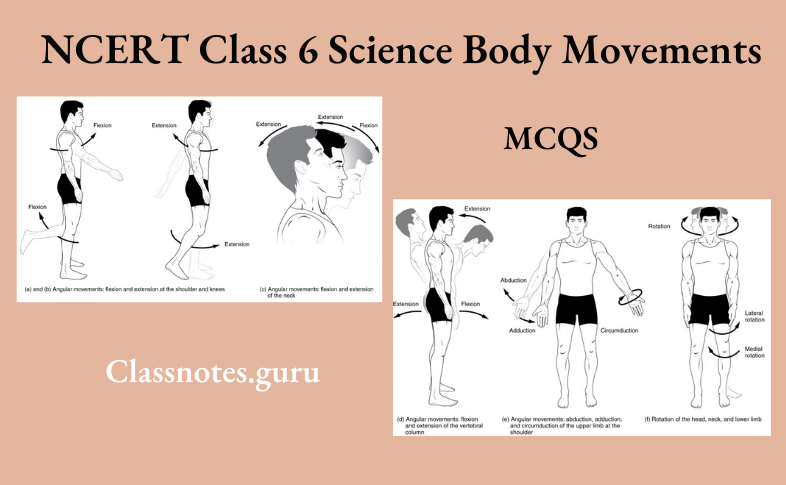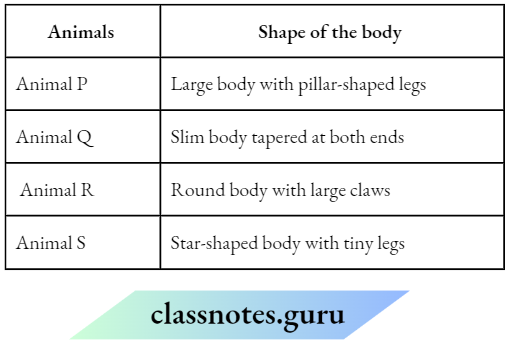NCERT Class 6 Science Chapter 5 Body Movement Multiple-Choice Questions
Question 1. Which of the following parts of our body help us in movement?
- Bones
- Skin
- Muscles
- Organs
Choose the correct answer from the option given below.
- 1 And 3
- 2 And 4
- 1 And 4
- 2 And 3
Answer: 1. 1 And 3
Question 2. Which of the following joints is immovable?
- Shoulder and arm
- Knee and joint
- Upper jaw and skull
- Lower jaw and upper jaw
Answer: 3. Upper jaw and skull
Read and Learn More NCERT Class 6 Science MCQs
Question 3. Human skeleton comprises
- Skull and backbone
- Ribs and breastbone
- Shoulder and hip bone
- All of these
Answer: 4. All of these
Question 4. How does the structure of the skeleton system support the body?
- It protects the outer skin of the body from any injury
- It provides a framework that gives shape to the body
- It provides the site for storing all the nutrients in the body
- It allows free movement of all the bones during locomotion
Answer: 2. It provides a framework that gives shape to the body
Question 5. The organ that protects the main nerve cord is
- Skull
- Backbone
- Breast bone
- Chest bone
Answer: 2. Backbone

Question 6. The bone formed from the collarbone and shoulder blade is
- Shoulder bone
- Chest bones
- Hand bones
- Backbone
Answer: 1. Shoulder bone
Question 7. Cartilages are human body parts that are attached to the skeleton. They are not as hard as bones, but they break when hit badly. Which of these human body parts is made up of cartilage?
- Nail
- Hair
- Nose
- Eyelid
Answer: 3. Nose
Question 8. How many muscles work together to move a bone?
- One
- Two
- Three
- Pour
Answer: 2. Two
Question 9. Muscles work in pairs. They contract and relax simultaneously. How does this help an individual?
- It assists in the formation of the bones
- It prevents any injury to the internal organs
- It allows the movement of bones at the joints
- It helps in the absorption of nutrients in the body
Answer: 3. It allows the movement of bones at the joints
Question 10. Which of the following organisms does not have both muscles and skeletons for movement?
- Dog
- Snail
- Earthworm
- Human being
Answer: 3. Earthworm
Question 11. Snail moves with the help of its
- Shell
- Bone
- Muscular foot
- Whole body
Answer: 3. Muscular foot
Question 12. In cockroaches, the body parts helping in movement include
- Three pairs of legs and two pairs of wings
- Two pairs of legs and two pairs of wings
- Two pairs of legs and three pairs of wings
- None of the above
Answer: 1. Three pairs of legs and two pairs of wings
Question 13. Which one of the following are the characteristics of birds?
- Strong muscles
- Light bones
- Hollow bones
- All of these
Answer: 4. All of these
Question 14. Both cockroaches and birds have wings to fly in the air. However, only cockroaches can climb on the walls. What is the likely reason for this?
- They lack muscles
- They have hollow bones
- They have strong and broad wings
- They have three pairs of modified legs
Answer: 4. They have three pairs of modified legs
Question 15. Which of these represents one of the reasons that enable birds and not humans to fly?
- They have long bones
- They have extra forelimbs
- They have strong hind bones
- They have hollow and light bones
Answer: 4. They have hollow and light bones
Question 16. Fishes swim by
- Forming loops alternately on two sides of the body
- Forming loops on a single side
- Somersaulting
- Alternate dipping and coming up
Answer: 1. Forming loops alternately on two sides of the body
Question 17. Underwater divers wear fin-like flippers on their feet to
- Swim easily in water
- Look like a fish
- Walk on the water’s surface
- Walk over the bottom of the sea (sea bed)
Answer: 1. Swim easily in water
Question 18. How can fishes flow around easily in the water?
- Due to small-sized body
- Due to a streamlined body
- Due to the presence of thin skin
- Due to the presence ofscales on their body
Answer: 2. Due to a streamlined body
Question 19. The table describes the body shape of four animals.

Which animal is likely to swim the fastest in water?
- Animal p
- Animal q
- Animal r
- Animal s
Answer: 2. Animal q
Question 20. The joint in the skull is a
- Gliding joint
- Ball and socket joint
- Fixed joint
- Hinge joint
Answer: 3. Ball and socket joint
Question 21. Which of the following is not correct regarding the human skeleton?
- All the bones are connected by joints
- Bones are made of calcium
- Bones can move by themselves
- Cartilage is also a part of the skeleton
Answer: 3. Bones can move by themselves
Question 23. The skeleton of the human body is made up of
- Bones
- Cartilage
- Both 1 and 2
- Muscles
Answer: 3. Both 1 and 2
Question 24. Which of the following is not a type of movable joint?
- Pivot joint
- Fixed joint
- Ball and socket joint
- Hinge joint
Answer: 2. Fixed joint
Question 25. How many bones are there in the human backbone?
- 31
- 33
- 32
- 35
Answer: 2. 33
